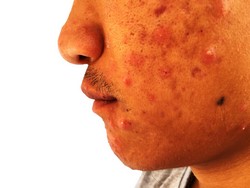Genetic and epigenetic cross-talk and effects on acne development
The EU-funded RNASEBGLAND (Regulation of gene expression in sebaceous glands) project has identified and linked common genetic programmes and their possible regulators in SGs that lead to this interesting dual function and related inflammatory diseases. Stimuli in acne and dermatitis, toll like receptor (TLR) 2 and four activators induced a significant number of genes in SG cells. Clustering these genes revealed that they are primarily involved in inflammation. Other previously unknown functions included chemotaxis and wound healing, indicating that sebocytes could interact with immune system cells and induce lymphocyte polarisation. The study uncovered the fact that genes involved in lipid metabolism are a major contributor to the dermal lipid environment. Manipulating these genes could modulate the homeostasis of the skin by targeting macrophages and keratinocytes. Using a set of RNASEBGLAND-developed marker genes, the researchers detected inflamed sebocytes. Results showed that sebocytes can respond to TLR activators. With an eye to new therapeutics, they tested the anti-inflammatory effects of various agents based on retinoic acid or vitamin D. Data from microRNA profiling revealed that the biggest changes in inflamed sebocytes were linked to nuclear factor (NF)KB signalling, notorious for its connection with inflammation. By contrast, in differentiating sebocytes, microRNAs targeted genes related to the c-myc pathway. Adipokines, responsible for the inflammatory properties of adipocytes, are also partially expressed in sebocytes and released in a stimulus-dependent manner. The scientists have selected genes involved in adipocyte biology for further study as they control maturation and lipid accumulation. RNASEBGLAND research results may increase knowledge on how skin bacterial microflora, hormone-regulated mechanisms and microRNAs could alter SG functions. Inhibition of sebocyte lipid production is the mainstay of pharma therapies for acne. Data from the project could be used to develop new drugs, where the emphasis would be on modulation of the different types of lipid produced.







